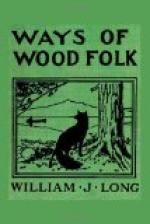These were some of the interesting things that were puzzling the watcher when he noticed that the hickory was empty. A flash over against the dark green revealed the leader. There he was, stealing along in the shadow, trying to reach the goal before they saw him. A derisive haw announced his discovery. Then the fun began again, as noisy, as confusing, as thoroughly enjoyable as ever.
When the bright object dropped this time, curiosity to get possession of it was stronger than my interest in the game. Besides, the apples were waiting. I jumped up, scattering the crows in wild confusion; but as they streamed away I fancied that there was still more of the excitement of play than of alarm in their flight and clamor.
The bright object which the leader carried proved to be the handle of a glass cup or pitcher. A fragment of the vessel itself had broken off with the handle, so that the ring was complete. Altogether it was just the thing for the purpose—bright, and not too heavy, and most convenient for a crow to seize and carry. Once well gripped, it would take a good deal of worrying to make him drop it.
Who first was “it,” as children say in games? Was it a special privilege of the crow who first found the talisman, or do the crows have some way of counting out for the first leader? There is a school-house down that same old dusty road. Sometimes, when at play there, I used to notice the crows stealing silently from tree to tree in the woods beyond, watching our play, I have no doubt, as I now had watched theirs. Only we have grown older, and forgotten how to play; and they are as much boys as ever. Did they learn their game from watching us at tag, I wonder? And do they know coram, and leave-stocks, and prisoners’ base, and bull-in-the-ring as well? One could easily believe their wise little black heads to be capable of any imitation, especially if one had watched them a few times, at work and play, when they had no idea they were being spied upon.
VIII. ONE TOUCH OF NATURE.
[Illustration]
The cheery whistle of a quail recalls to most New England people a vision of breezy upland pastures and a mottled brown bird calling melodiously from the topmost slanting rail of an old sheep-fence. Farmers say he foretells the weather, calling, More-wet—much-more-wet! Boys say he only proclaims his name, Bob White! I’m Bob White! But whether he prognosticates or introduces himself, his voice is always a welcome one. Those who know the call listen with pleasure, and speedily come to love the bird that makes it.
Bob White has another call, more beautiful than his boyish whistle, which comparatively few have heard. It is a soft liquid yodeling, which the male bird uses to call the scattered flock together. One who walks in the woods at sunset sometimes hears it from a tangle of grapevine and bullbrier. If he has the patience to push his way carefully through the underbrush, he may see the beautiful Bob on a rock or stump, uttering the softest and most musical of whistles. He is telling his flock that here is a nice place he has found, where they can spend the night and be safe from owls and prowling foxes.




